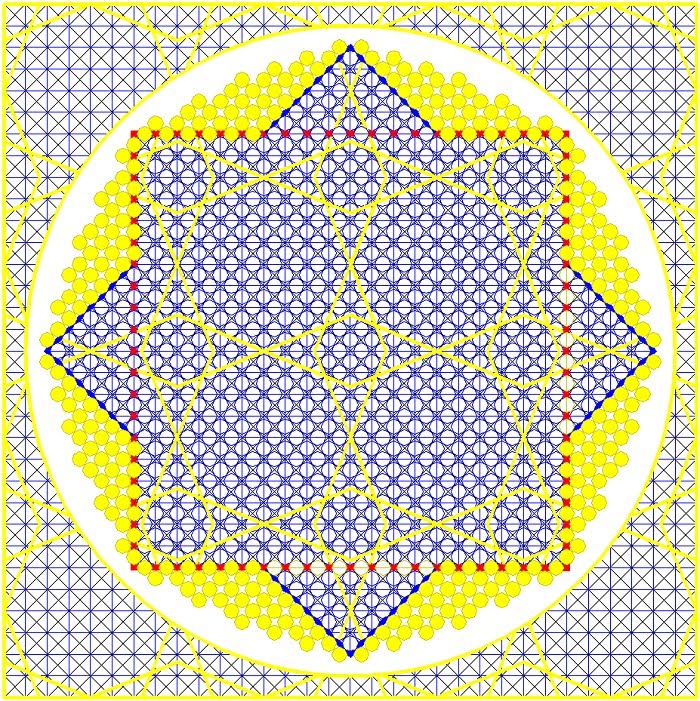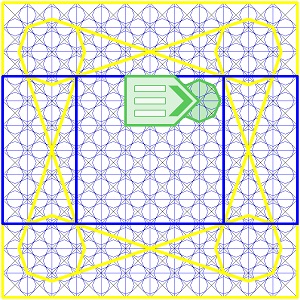In
this post I will reveal one of the last formats, which Involves the "Parallelograms".
I then want to continue with the "Programming" side.
HOW and WHERE we can make Practical use of this Knowledge.
I then want to continue with the "Programming" side.
HOW and WHERE we can make Practical use of this Knowledge.
These "Parallelograms" can be found in;
a. The
"Hexagonal Format". (6 Pointed Stars)
b. The "Square Format".
and
c. The "Octagonal Format".
1st showing the "Parallelograms" within the "6 Pointed Stars" used to Access
the
"Main Permanent Libraries".
The Drawing below, shows the "Control Program Parallelogram".
The "Parallelogram"
allows access to the "Library Contents".
And
in this next Drawing divided into its 4 "Sectors".
If this "Parallelogram"
is Flipped Horizontally, it now gives Access to the "Program
Contents".
And its 4 "Sectors".
The 3rd "Parallelogram" is presented in this next Drawing.
and next showing its 4 "Sectors".
I will reveal more about these
"Parallelograms", but 1st I want to show the
"Parallelograms"
involved in the "Square
Format" as well.
Then I will show the "Components"
of the "Parallelogram" which relates to ALL
the "Parallelograms".
The "Parallelogram"
is a "Geometric Instruction" and has Nothing at all, to do with
the overall boundaries of the "Libraries".
The "Square" is
also a "Geometric Instruction", having Nothing at
all, to do with
the overall boundaries of the Libraries either.
The "Square
Instruction" (Format) refers to the "Main Temporary
Libraries".
These "Temporary Libraries" are
used a bit like RAM in our Computers we use
on earth today, but instead
of using Binary it uses "Geometry" with "Recognition",
a bit like a "Comparator".
So here is the 1st of the
"Parallelograms" in the "Square Format".
It can be Identified as the "Control Register".
And in this Next Drawing
"Partitioned" into the Upper and Lower "Program Sectors".
And the "Program
Register".
And it is also "Partitioned"
into Upper and Lower "Program Sectors".
And the 3rd "Partition"...
This is also "Partitioned"
into Upper and Lower "Program Sectors".
If we ignore the "Masks" and just
consider the 2 "Frames" Only...
We find the 4 Corners of
the "Square Frame" are located in the Corners of the
Large
YELLOW Octagon.
In these Locations exist 4 smaller Octagons used in Programming (Communication)
shown here in YELLOW.
The Color YELLOW is the "Color Code" for the "Present".
In this next Drawing, the Octagons
are shown in GREEN.
The Color GREEN is the
Color Code for the "Contents".
In this next Drawing the Octagons
are shown in BLUE.
The Color BLUE is the
Color Code for "Importing".
And here showing the 4 Octagons (Registers) with the "Square Frame".
Here are the Program
"Instructions" which are used in "Program
Script".
This Letter or Glyph indicates
the "Program Register Square".
And as the 4 "Squares" are arranged in a "Stack"
in this Format, this next "Instruction"
Letter or Glyph indicates the "Control Register Square".
Letter or Glyph indicates the "Control Register Square".
NOTE; The
"Instruction" shown here, is in BLUE, producing a BLUE "Frame". (Square)
This next "Instruction"
indicates the "Scratch Pad Register Square".
And the Last of these 4 "Instructions", (A Rotation of the same Letter
or Glyph) indicates
the "Picture" or "Data Register" in the Lower Left.
"L" for Lower and Left.... LOL.
Perhaps this where the Shape of the Upper case "L" originated from ?
the "Picture" or "Data Register" in the Lower Left.
"L" for Lower and Left.... LOL.
Perhaps this where the Shape of the Upper case "L" originated from ?
Here are the
"Instructions" used in "Program Script"
for the "Parallelograms".
And as these are also in a "Stack" this 1st "Instruction" indicates the "Control Register".
This next "Instruction"
Refers to the Upper "Running Program Register" of the
"Control Register".
This next "Instruction"
in the Drawing below, refers to the "Picture" or "Data
Register".
And the last of these
"Instructions" refers to the "Scratch Pad
Register."
Once again, a Rotation of
the same Letter or Glyph !
The Color of the Octagons "Frame" (Outer) indicates the Color of the "Frames".
Here we see in this next Drawing
an Octagon with a GREEN "Frame" or "Border"
with a WHITE "Mask" and a GREEN "Instruction" Letter or Glyph in it.
with a WHITE "Mask" and a GREEN "Instruction" Letter or Glyph in it.
So this Indicates a GREEN "Parallelogram" on a WHITE Background.
But if the same Octagon was to have a GREEN "Mask", rather the the WHITE "Mask"
shown previously the "Parallelogram" would then be on a GREEN "Mask".
Here are the 1st of the Inner "Instructions" for the "Parallelograms".
1st is the "7".
This "Instruction" sets or "Enables" the "Mask" Inside the "Parallelogram".
I have shown these "Instructions" in BLACK but if the "7" was GREEN, then a GREEN
"Mask" is "Enabled".
I wonder if this is where the
Number, "7" originated from ?
When the "7"
appears for the 1st time in the "Script", it Enables the "Mask" and if
it is used again, it removes the "Mask".
And if used a 3rd time, it installs the "Mask" once again and so on.
In other words some of the "Instructions" are "Toggle".
it is used again, it removes the "Mask".
And if used a 3rd time, it installs the "Mask" once again and so on.
In other words some of the "Instructions" are "Toggle".
The Next "Instruction"
Opens the "Upper Sector" of the "Mask"
Only and the "Library
Partitioning" can be seen through the "Mask".
Partitioning" can be seen through the "Mask".
The next "Instruction"
opens both the Upper and Lower "Sectors".
And this next
"Instruction" allows Access to the Upper, Lower and Mid "Sectors".
The "Library
Partitioning" seen through the Opening in the "Mask"
can be shifted around
Laterally in any direction.
Laterally in any direction.
But as this operates as a
"Conceptual Processing System" and All involves only
"Instructions",
the "Library Partitioning" only requires, to indicate a "Transition", then Stop
and an "Instruction" is then entered in the appropriate Location determined by the Programmer.
the "Library Partitioning" only requires, to indicate a "Transition", then Stop
and an "Instruction" is then entered in the appropriate Location determined by the Programmer.
These are just a couple of examples involving Locations the "Library Partitioning"
can be Stopped in, which I will explain more about in my next post.
can be Stopped in, which I will explain more about in my next post.
NOTE;
To gain the full understanding, please Start this "Thesis" from the beginning at 0001
if you haven't already...


































































